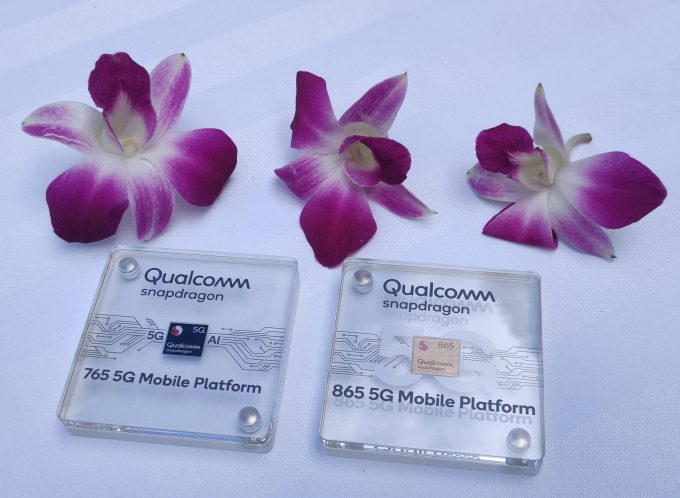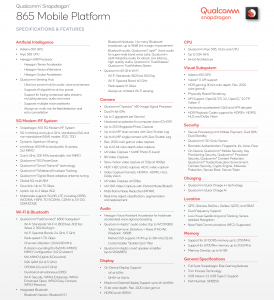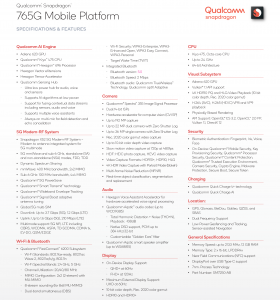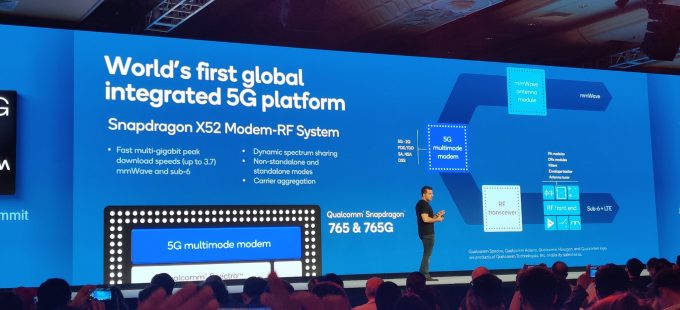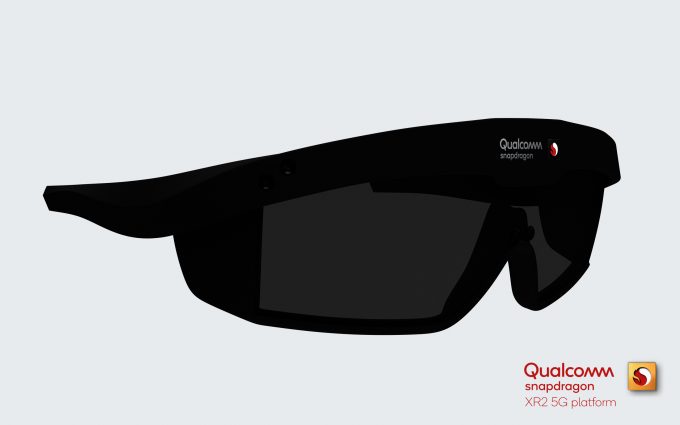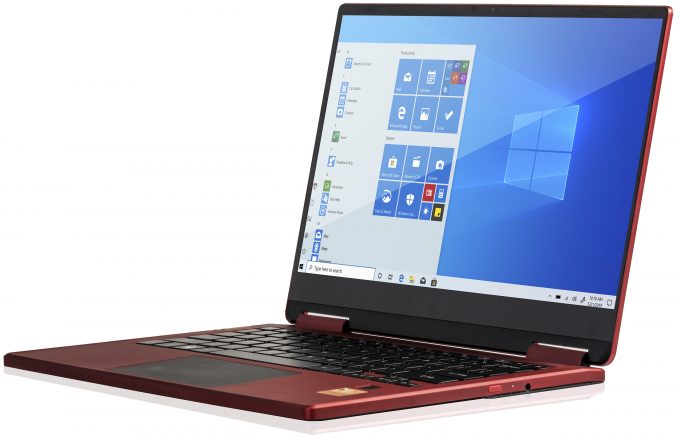- Qualcomm Launches Snapdragon 4 Gen 2 Mobile Platform
- AMD Launches Ryzen PRO 7000 Series Mobile & Desktop Platform
- Intel Launches Sleek Single-Slot Arc Pro A60 Workstation Graphics Card
- NVIDIA Announces Latest Ada Lovelace Additions: GeForce RTX 4060 Ti & RTX 4060
- Maxon Redshift With AMD Radeon GPU Rendering Support Now Available
Qualcomm Snapdragon Tech Summit 2019 Event Overview

Three days of Qualcomm’s Snapdragon Tech Summit, we get to dive into the big features and specifications of the new 865 and 765/765G processors, 5G modems, and sensor hub. There’s also big changes to gaming, with GPU drivers as an app, desktop rendering features coming with Unreal Engine, and the XR2 VR platform. Also a quick update on the 7c and 8c processors for Windows.
Article update on Dec 5th to include details of day three of the event.
In Maui, Hawaii, Qualcomm is holding its annual Snapdragon Tech Summit. Last year we saw the introduction of 5G, and the first generation of hardware to take advantage of it, such as the Snapdragon 855 SoC.
We saw yesterday Qualcomm’s continued expansion of 5G services, but with more of a focus on AI, in conjunction with 5G and the impact it’s had, and will have on the world. We also saw the latest Snapdragon SoC packages and 5G modems. Today, we get to share the details of what will be going inside these chips, such as the new AI processing capabilities, sensing hub, GPU features, and the exciting camera technologies. It’s worth reading up on what was covered last year to familiarize yourself with some of the underlining tech, since this year builds on a lot of that work.
The Snapdragon 865 entails a number of improvements that we’d expect from a flagship processor. It’s not all about doing more with less, but also adding features and new ways of thinking. At a high level, we see the usual 20-30% improvements in performance and power efficiency, but when you dig deeper, there’s a lot more going on.
There are three main focuses that Qualcomm put into its Snapdragon 865 chip, encompassing Artificial Intelligence (AI), the camera, and finally, gaming. From a consumer perspective, AI is not really a big seller, but it’s used extensively for a lot of functionality that people have come to expect from their mobiles. The camera and gaming aspects, however, are pretty self-evident as to their importance.
The Camera & Spectra 480
The Spectra 480 Image Signal Processor (ISP) is a whole other level when it comes to video and camera tech. In previous iterations, we’ve always seen some of the cool stuff Qualcomm’s chips could do, intermixing AI and its sensors to do spatial tracking of fingers, motion stabilizing, night-time noise rejection and so on. This time, Qualcomm was all about raw throughput, 2 gigapixels per second to be precise.
The new sensor can capture 4 pixels per clock instead of a single pixel. This extra data capture means that less clocks are needed to save an image, which means the processor can run at a slower speed, saving power in the process. The camera module can simultaneous capture 4K HDR video, plus a 64 Megapixel photo at the same time. Depending on the camera unit that integrators may use, the Spectra 480 can support camera sensors up to 200 megapixels.
We will also see the introduction of 8K video capture, which is 33 megapixels per frame, an enormous amount of data. To really lay the camera tech on thick, Snapdragon 865 will be the first platform to support video capture using Dolby Vision in 4K, a first for such a device. If HDR isn’t your thing, how about slow-motion? 4K video can be captured at 120 FPS, and can be stretched further with SLO-MO using a lower resolution, at up to 960 FPS. This slow motion capture isn’t just limited to half a second recording like many others, but can be set to continuous recording, although you’ll need a fair amount of high-speed storage to cope.
Gaming & Adreno 650 GPU
The Snapdragon 865’s GPU is getting its usual performance uplift that you’d see with a refresh, but with a few extras being thrown in, too, beyond just performance. First of all, the Adreno 650 GPU is about 20% faster than the Adreno 640 used in the Snapdragon 855, and is 35% more power efficient, too. Qualcomm was quick to point out though, that they plan to bring desktop gaming features to the mobile platform.
The first big item is something that we on the desktop take for granted, and that’s drivers. New games come out, optimizations too, but the GPU drivers need updating too to make the most of it. Mobiles typically do not have this luxury, and instead have to wait for such device drivers to roll out with Android system updates, if they ever come out at all.
Qualcomm will be switching its GPU drivers away from a system component, over to an app, meaning that the GPU driver can be updated when it is needed, and not when a carrier feels like it. This will help with providing consistent behavior for all users, and not those who were lucky enough to get updates.
In addition to this, it would appear that Epic is throwing some money at Qualcomm as well with better support for Unreal Engine, and support for desktop graphics features in what Qualcomm is calling Snapdragon Elite Gaming. This includes Unreal’s Desktop Forward Rendering engine, which allows desktop effects to be ported over to the mobile platform, such as various lighting effects, dynamic shadows, planer reflections, and motion blur. There will also be something called ‘Game Color Plus’ which mimics the effects of HDR lighting in normal games, but without oversaturating the color. A number of demonstrations were shown and will be added later.
AI, Hexagon & Kryo
As mentioned previously, AI from a consumer perspective is rather intangible, it’s not some big selling point in of itself, but is used extensively from all the various connected Apps and services that are used on your mobile. Object and face detection on the camera, voice and audio filtering to pick out words and commands from background noise, and even real-time language translation. It will also be used for things such as augmented reality, performing overlays on video from your camera.
The Hexagon core in the Snapdragon 865 had its Tensor accelerator updated by more than two-fold, to 15 trillion operations per second, all with an improved power efficiency of 35% over the previous generation.
There is also an all-new component in the stack, Qualcomm’s Sensing Hub, which is an ultra-low power sensor manager. Its primary purpose is to keep an eye on, and an ear out, for certain events and triggers, such as voice commands, where it will turn on the main CPU and AI engine to process what’s going on. It’s a low-power standby for the AI, listening out for key words or sensor triggers, without the CPU constantly pinging the sensors directly. This little sensor hub uses less than 1 mW of power, another power saving on top of all the others. Integration with Google Home, and Amazon Alexa is already available, with the sensor hub capable of detecting multi-word wake-up commands.
The Kryo CPU has been updated to 585. This CPU design is similar to previous versions in that it’s a mix of different core speeds and sizes for different workloads. The ‘Prime’ CPU is based on ARM Cortex-A77 and scales to 2.84 GHz with 512KB L2 cache. There are three ‘Performance’ CPUs running at 2.4 GHz with 256KB L2 cache each. The ‘Prime’ and ‘Performance’ cores make up the big CPUs. There are four small ‘Efficiency’ CPU cores based on ARM Cortex-A55, running at 1.8 GHz with 128KB L2 cache each. All cores share 4MB of L3 cache. This also marks the Snapdragon 865’s jump to support a new memory architecture, LPDDR5, up to 16GB running at 2750 MHz.
5G & WiFi 6
Qualcomm’s biggest endeavor would arguably be the promotion of its 5G network, infrastructure, and world-wide rollout. 5G is the biggest change the cellular industry has seen, as it sets out to not only fix many of the shortfalls of previous generations, but completely change how mobile communications work. Lower latency is one of the biggest changes for 5G, but so too is the incredible amount of bandwidth it can support.
The latest modem Qualcomm has developed, as part of the X55 5G Modem-RF system, will be capable of peak speeds of 7.5 Gbps, that’s practically an order of magnitude greater than any previous generation, and significantly faster than the vast majority of landlines that people see with Cable and DSL technologies. The X55 modem can do this because of its use of a separate package, and isn’t integrated into the main SoC. There are pros and cons to this kind of solution, but the speed benefits it can achieve are substantial. The Snapdragon 765 integrates the modem to keep costs down, and reduces this bandwidth, but still capable of some impressive throughput.
5G support is just one aspect, as Qualcomm covers the full range of radio technologies, including WiFi 6 at 1.8 Gbps using an 8×8 MU-MIMO configuration and WPA3 security, regional bands such as mmWave and sub-6, Non-standalone (NSA) and Standalone (SA) modes, and finally Dynamic Spectrum Sharing, allowing for 5G and 4G networks to be used at the same time. There are also Bluetooth standards updates, supporting BT 5.1, aptX Voice, aptX Adaptive, and TrueWireless.
Snapdragon 765 & 765G
Qualcomm’s Snapdragon 765 is a more mainstream chip that will find its way into many more devices, and at a lower cost. It’s a cut down 865 that integrates the X52 5G modem bringing its bandwidth down to 3.7Gbps, which is a fair jump down, but still significantly faster than most other connections. It can perform the same Spectrum sharing, allowing both 5G and 4G.
The Snapdragon 765 AI engine is similar to that of the 865, but only capably of 5.5 TOPS instead of 15. The Kryo 475 CPU has a single Prime core at 2.3 GHz, a performance core at 2.2 GHz, and 6 Efficiency cores at 1.8GHz.
The Spectra ISP has 4x power savings over its predecessor. and brings 4K HDR video and HDR10+ down to mainstream SoCs. SLO-MO is also enabled, but limited to 480 FPS instead of 960 – which is still impressive for a mainstream part.
Qualcomm is also introducing a more gaming focused version of the Snapdragon 765, with the rather imaginatively named 765G – the G for gaming. This SoC is basically the same as the 765, but the Adreno 620 GPU has been pre-binned and clocked 15-20% faster. You’ll likely see this chip more in gaming focused devices and potentially AR/VR headsets, although it may have competition with a different kind of chip from Qualcomm, which is to be announced later.
Coming Soon
At the end of day two, we got to see some of the more detailed aspects about Qualcomm’s chips, but there is still more to come, namely some of the hardware and reference designs for these new chips. There is also two big areas that haven’t been touched on, such as how Qualcomm is moving with its Windows on ARM 8cx chips we saw earlier this year, and the ever-growing eXtended Reality (XR) that was briefly mentioned on day 1 of the tech summit.
Day Three: Augmented And Virtual Reality With XR2 Processor
On the third day of Qualcomm’s Snapdragon Summit 2019, it was time for eXtended Reality (XR) with all new AR and VR headsets, a new platform, and of course, compute with the always-on Windows for ARM processors.
We saw a jump in performance with the Snapdragon 865, and the rollout of 5G over the previous two days. We also saw new gaming features with Snapdragon Elite Gaming. Combine the two and putting them inside a pair of glasses, and you have the building blocks for Qualcomm’s next mixed reality headsets.
The Snapdragon XR2 SoC platform builds on the popular XR platform that Qualcomm introduced just over a year ago. Nearly every single standalone VR headset on the market was built around Qualcomm’s technology. Oculus Go, Vive Focus, Lenovo’s Mirage Solo, Microsoft’s Hololens, and many more, all use Snapdragon processors.
The XR2 will have twice the CPU and GPU performance over the current XR platform, 4x more video bandwidth, and 6x higher resolution, just keep in mind that the existing XR SoCs are built around the Snapdragon 835. Shaders and pixel fill rates have been increased by 50%, and resolutions of 2.5k per eye at 120 FPS (3K oer eye at 90 FPS) are possible. Add native support for 5G connectivity, and you have the building blocks of a truly standalone mixed reality headset.
XR2 will support up to 7 cameras, which can be used for more than just wide-field view, but can be turned towards the user for eye and lip tracking to engage in-game with what you are looking at, as well as synthesize speech animations. There is 26-point skeletal hand tracking, so you can interact with objects without a controller, and facial expressions to aid in social interaction. All of this to help build immersion in games. This is all on top of the six-degrees-of-freedom the platform could support before.
AI comes into the mix too with object detection of your surrounding environment. While virtual reality is about building a whole new world, it still helps to be aware of your natural boundaries. Augmented reality is where the real promise is, not just for playing games out in traffic, but for training and business. It’s possible to do the equivalent of photogrammetry to rebuild the real world in the virtual.
It’s not just cameras and object detection that AI can help with, but voice commands and audio analysis. Issue commands in-games to talk to NPCs, command teammates, even add immersion with spell chants and the like. Audio analysis is also helpful for alerting you to the real world when you are immersed, by alerting you to door bells, or your child crying – or at least, that’s one possibility. Real-time translation of spoken word to text, to another spoken language is also possible.
More advanced rendering features are supported too, such as variable fill rate, a technique used in foveated rendering which relies on eye tracking to only render a part of a scene directly where you are looking, and using lower resolution rendering in your peripheral gaze.
Multiple partners will be showing off their new headsets over the coming months, making use of the new XR2 platform. This is thanks in part to Qualcomm’s reference designs, which includes full layouts, schematics, and bill of materials.
Snapdragon 7c & 8c Processors
Qualcomm has gained great traction in the PC market as part of its Always-Connected branding when it comes to Windows on ARM computers. What originally felt like a relaunch of Windows RT, Qualcomm and Microsoft were quick to prove that this was not another failed ARM launch.
Last year we saw the introduction of the Snapdragon 8cx processor, a premium option for the Windows on ARM platform. What was lacking at the time, was any kind of entry-level or mainstream platforms to get more people involved with the project, which is what will be corrected today.
As part of the roundup for the last day at Maui, Qualcomm announced two new AC-PC chips, the Snapdragon 7c and 8c processors. We’ve already seen early adoption by a number of companies including Samsung with the Galaxy Book S, Lenovo with Project Limitless, and of course, Microsoft’s own Surface Pro X.
All these devices with have 5G connectivity, and will be paired with AI processors, with even the 7c hitting 5 TOPS of AI compute, and 6 TOPS on the 8c. These systems all share large battery lives of 20+ hours of real-use. The instant wake-up and sleep modes also means that devices can be used throughout the week, even with heavy use since standby power is so low. They’re built on a 7nm process and capable of gigabit LTE as well.
The 8cx was paired with a new enterprise SKU which has a number of security options, biometrics, the sort of options that Windows Enterprise will take advantage of. There were also a number commitments from software vendors too, as the platform has matured beyond what was seen with Windows RT, thanks in part to the emulation of x86 instructions when required. Adobe has pledged its support for the platform, and will begin work on an ARM version of its suite, although there are little details as to the extent at this time.
With new mainstream and entry-level systems which are likely to start at around the $4-500 range, it seems that Qualcomm has managed to crack the Windows ARM market, and we may finally see some long-life battery laptops with a wide selection of software.
Support our efforts! With ad revenue at an all-time low for written websites, we're relying more than ever on reader support to help us continue putting so much effort into this type of content. You can support us by becoming a Patron, or by using our Amazon shopping affiliate links listed through our articles. Thanks for your support!




